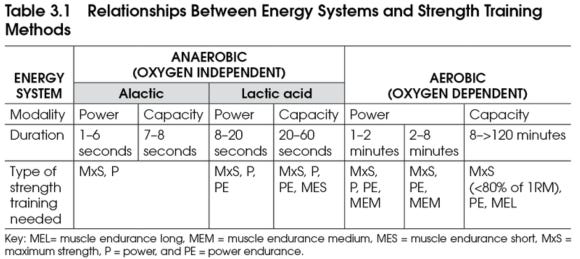Fitness charlatans, influencers, and hucksters often use (A) confusing, verbose terminology and (B) proprietary "functional" methods. Even with the best intentions, it’s often trying to reinvent the wheel and has a marginal, sometimes even detrimental, effect on outcomes.
I’m as guilty as anyone of wanting to flex my mental muscle, use big words, and scientific-sounding terminology. Sometimes this is useful for the technically inclined. Often it’s overwhelming to the novice.
There’s a sea of information online, some good, some terrible, a little great, and a lot of mixed messages.
There’s a lot of bickering online about energy systems and “intensity.” While, biologically, there are some guidelines, the absolutes are largely irrelevant. This is because all of our body’s energy systems are all working all the time.
To different degrees and proportions to meet different demands, yes, but they are all “on” no less.
For future reference, all of my training sessions are documented in the subscriber chat, along with detailed descriptions of the session’s “intention” and what I learned from training that day. More about how I design specific sessions will follow in part 2 of this series.
Choosing a Focus:
I start a given training block or program by deciding what I want to focus on or develop throughout that program. The same is true for individual sessions.
In the simplest terms this may be skill, fitness, or conditioning. Skill refers to sport “practice.” Fitness refers to physical attributes. Conditioning refers to the overlap of the two.
In this post I’ll be talking exclusively about a fitness focus.
Definitions of energy systems are subject to some debate (see chart above), but the technical descriptions and experiential definitions I’ve offered below should be enough to guide you in the right direction.
Technical Descriptions:
Endurance (END): Endurance is simply the ability to persist, to keep going. The key questions are “how far” and “how long.” If we start asking “how fast”, we’ve entered a different territory. Not every endurance session has to be long, but it does have to be the “pace” you could hold for a long time. For a fuel source this system is about 90% oxidative (ref.) — fueled by oxygen and fat.
Strength (STR): Strength is the ability to hold tension. Phrased differently, what is the maximum tension we can produce and hold? Fuel here comes from phosphagen and glycolytic pathways (ref.). Therein we have some overlap with endurance when developing hypertrophy, hence the phrase “strength-endurance.” Generally, when we start timing rest intervals we’ve left the territory of absolute strength.
Power (PWR): Power is the ability to apply force dynamically; energy divided by time. Sometimes this is expressed as an explosive movement, but also by other outputs such as watts. As for fuel substrates, we’re talking about >90% phosphagen pathways (ref.).
Mobility (MOB): Mobility is the degree to which one feels discomfort in building new neuro-muscular pathways, and relief in repeating them. It seeks to improve range of strength and control of articulation.
(Work) Capacity is the most nebulous to define. We can be limited by either or both movement (mobility) or re/metabolizing of fuel sources (CO2 clearance, lactate threshold, etc.).
When we look at the emotional or experiential definitions below, “work capacity” falls into two main categories in my opinion. Fortunately, I don’t have to bee too clever here as biochemistry textbooks have provided adequate verbiage:
“Anaerobic capacity is most commonly reported in terms of peak power output, whereas aerobic capacity is usually expressed in terms of peak oxygen consumption.”
Anaerobic Capacity (ANAC): This is the ability to recover between intervals; be they sets, rounds, days, or weeks. There is a wide purview of application here, but all trigger the build up of lactic acid. The key feature here is a passive or impaired interval between designated “work” intervals. Previously I’ve referred to this as “recoverability", but the abbreviation REC can get confused with “recovery sessions” (see below regarding difficulty descriptions).
Aerobic Capacity (AERC): This is the ability to clear waste products while actively working; also known as oxygen mobilization. Technically, oxygen mobilization is the more accurate descriptor, but the abbreviation O2 was confusing when talking about the aerobic (END) system. This is really the steak-and-butter of capacity work as it allows you to “find the edge” or “the end of intensity” where you must “downshift” to an endurance pace.
Google Form: What emotions do you experience during these training formats?
Experiential / Emotional Expressions:
I’m working on a list of emotions as they correspond to each of the above energy systems. You can contribute by filling out the above Google Form.
As with physicality, emotionality can be a powerful descriptor and can have many more shades of grey and nuance.
An endurance cycle, of any duration, predictably follows the “stages of grief”; which might as well be the stages of life. Settle in, grind, grieve, learn to love the process. This will not be over soon and there is no way to rush it along.
Mobility is about flow and growth, which we should anticipate to be painful, but also bring a sense of relief. We are challenged but not threatened.
As for anaerobic capacity, I entered the following description of my experiences with this system into ChatGPT and asked it to describe an emotion:
pain, burning, nausea, vomiting, bowel release, diarrhea, desperation
Notoriously, I have a trauma response when this is pushed hard. Some people puke, I tend to shit myself. Of ChatGPT’s proposed emotions, agony and distress fit best — “It often renders a person unable to focus on anything other than the source of their distress… A person experiencing distress feels out of control, often desperate for a resolution to whatever is causing their pain or discomfort.”
Similarly, for aerobic capacity, ChatGPT gave this response to my description:
“Panic encapsulates an intense and overwhelming sense of fear and desperation, often accompanied by physical symptoms such as difficulty breathing, rapid heartbeat, and a feeling of impending doom.”
Well played SkyNet!
In my experience a tell tale sign of an “appropriate” aerobic capacity session is a “smoker’s cough” for the next few hours.
It’s also noteworthy that I usually have to regulate fear and anxiety (different from the dread of endurance), ahead of aerobic capacity sessions. Anaerobic capacity sessions tend to hit harder and faster, think fight-or-flight.
While trying to describe the emotions I associate with power, I recalled that I happened to be at the gym and noticed that my friend’s preferred brand of ammonia salts was called “insanity.” So, I asked ChatGPT to describe “insanity.”
“This (insanity) emotion may oscillate between manic euphoria, crushing despair, or volatile unpredictability, accompanied by an inner sense of loss of self or purpose.”
That sounds like Olympic Weightlifting to me!
That brings us to strength. This one’s not too difficult to imagine. If our operational expression is “holding tension” then a corresponding emotional expression may be a helpless pressure. If you can’t pull a certain load, there’s no negotiating, no bargaining, no enduring; it’s simply the end of the road and you either lifted it or you didn’t.
Whichever expression you choose to develop, keep this in mind:
Get it done while you can, because no one gets out alive!






